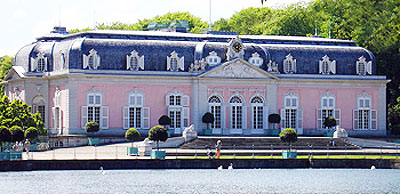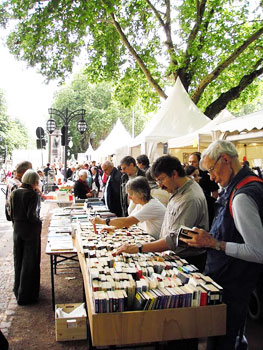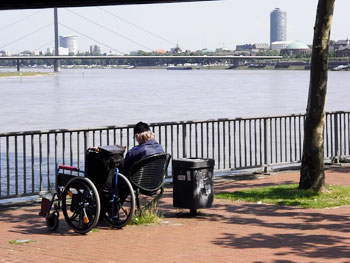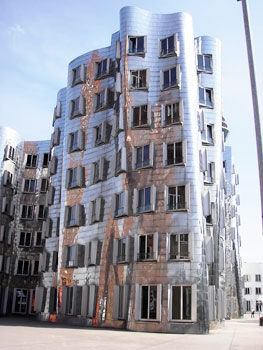
Düsseldorf, Old and New
By Gary Singh

“Eighty percent of Düsseldorf was destroyed during the war,” explains Renate Morton as she escorts me through a supreme navigation of the city streets. A tiny firecracker of a personality, Morten says she’s been around for a long time.
Although she spent years living in both England and South America, she is Düsseldorf’s resident woman-about-town.
A walking encyclopedia, Renate is on familiar terms with every single crack in the pavement and every juicy tidbit behind every new development project. She knows both old and new.
As we embark on a walking voyage, historical facts gradually emerge like bubbles in a boiling pot of water. Renate tells me that Claudia Schiffer was discovered in a nightclub in Düsseldorf. I learn that Düsseldorf has Europe’s largest Japanese population. She spills the goods on statues, galleries and herbal liqueurs. Her enthusiasm is infectious.
The hits keep on coming. As we segue into a store called Tchibo, which sells coffee and women’s underwear, she informs me that Düsseldorf’s primary historical hero is Johann Wilhelm, Elector Palatine. He accomplished three main things: He started an art collection; he gave the brewers the right to form a guild; and he allowed Protestants to settle in the area.
As I ingest Renate’s enlightening rapid-fire explanation of all things Düsseldorf, I can’t even take notes. I felt like I’ve awakened to a great multi-dimensional quantum field from which the rest of my experiences would derive. Every aspect of my subsequent spree through Düsseldorf feels like a quantum wave function of her supreme tour. What follows here are just a few of those trajectories.
Pearl of Aesthetic

Naturally, the place exudes a crispy-clean antiseptic aura that one would expect. A few minutes after I enter the facility, Dr. Branislav Matejic appears from around the corner.
Tall and thin, with gray hair and glasses, he’s dressed in a sportcoat and jeans and exudes the air of a laidback movie personality. In fact, he resembles the German director Wim Wenders.
One of the Capella Hotels, the opulent Breidenbacher Hof tops all the lists, but the accommodation can also claim unique status as the only one in Düsseldorf attached to a full-blown elite plastic surgery clinic. Inquiring minds can enter Pearl of Aesthetic from either the hotel or by a private door down the street.
A leading surgeon in Europe and an internationally acclaimed superstar, Dr. Matejic has operated on numerous celebrities and members of royal families. Aside from owning Pearl of Aesthetic, he frequently appears on radio and television and consults at clinics all across the globe.
Getting a tour of this private plastic surgery clinic straight from the maestro himself was nothing short of awe-inspiring. Facetiously speaking, it’s like visiting the legendary Gruhn Guitar shop in Nashville or the J.M. Capriola saddle shop in Elko, Nevada — both bastions of cosmetic repair in their own right.
Medical tourism is big in Düsseldorf, especially with folks from Russia and the United Arab Emirates. Many plastic surgery clinics exist, but the Breidenbacher is the only luxury accommodation providing a convenient all-in-one package. Everything is under one roof. Patients can go directly from the hotel to the clinic and vice versa. They don’t have to walk outside after surgery or in bandages.
Dr. Matejic explained that patients often bring their entire families with them when they stay at the hotel and subsequently undergo an operation. The Breidenbacher provides all the privacy one needs.

Palace Benrath
With huge slippers on my feet so as not to disturb the priceless flooring inside Palace Benrath, I spend an hour with yet another a remarkable tour guide. I can’t imagine anyone knowing more than Nadine Odenthal about the famous late-Baroque mansion. With impeccable English, she explains the sordid details on each and every room we explore. The slippers are awkward to put on and take off, but each visitor is required to wear them.
As the story goes, Benrath Palace’s original intended owner, Karl Theodor, built it for his wife, who never used actually used it. From outside, the palace looks like it has two stories, but it actually has four. There’s also a hunting lodge, a separate restaurant, extensive gardens and three separate museums. In a postcard sight, the 450-meter pond outside reflects the main building. The architect Nicolas de Pigage designed both the palace and the grounds as a total work of art.
After numerous wars, remodels and phases of redevelopment, today the property attracts visitors primarily for the park, which tips the scales at 612,000 square meters. The elaborate garden combines formal European and Eastern designs. In front of the palace, kids often play with radio-controlled toy sailboats in the water. Joggers use the park for their daily runs. Swans often show up to pass the time away.

Since I’m traveling through Düsseldorf during the 2010 World Cup and since Odenthal herself is a huge soccer fan, we engage in fruitful banter about Germany’s defeat of the US in the 2002 World Cup Quarterfinals. I then mention that I grew up watching German soccer highlights on PBS as a kid in the 1970s. Together we rattle off German heroes from those days: Toni Schumacher, Sepp Maier, Gerd Müller, Uli Hoeness, Karl-Heinz Rummenigge and the list goes on. I can’t tell if I’m impressing her or not.
As a born-and-bred American soccer fan, I feel especially welcome in Germany, where everyone seems soccer-crazy. The sport is indeed the universal language. Even if one doesn’t arrive during the World Cup — which is every four years — the local league club, Fortuna Düsseldorf, plays at the Espirit Arena.
Between Beer and Books
Located just off the Heinrich Heine Allee U-Bahn station, the Breidenbacher Hof sits in-between Düsseldorf’s old town area (Altstadt) and the city’s main shopping drag, Königsallee, or the Kö for short. Due to the particular season, I find the hotel to be right smack between beer and books.
Naturally, I ask one of the personal service attendants to recommend an appropriate pub to watch soccer. With impeccable English, he directs me to McLaughlin’s on Kurzestrasse and a few others on Hunsrückenstrasse.

Altstadt is known for over 200 bars, restaurants and cafes, so the area is officially called “The Longest Bar in the World.” Cobblestone pathways twist off in every direction, but getting lost is never a problem because the neighborhood, somehow, comes off as not really being that large.
The glorious Rhine sits on one side, while the U-Bahn station marks the other side, providing an easy and compact environs for watching the Alt Beer flow.
As I saunter in, I see that McLaughlin’s provides an English-language broadcast of the World Cup matches and a barmaid with rocking tattoos, which is perfect. Natives and expats alike glue themselves to a few dozen screens. Not for one second do I feel like a stranger.
Coincidentally, I’m also hitting town during Düsseldorf’s famous international book spree on the Kö (Bücherbummel auf der Kö). Each year during the summer, about120 book vendors set up booths along one entire mile of the street. The spree lasts four days and I arrive at a splendid time, as it is the fair’s 25th anniversary.
Ninety-nine percent of the books are in German, of course, but that doesn’t stop me from wandering in and out of what seems like an endless display of many different kinds of reading materials: travel books, antiquarian volumes, dollar bins, history books, essays, computer books and much, much more.
Schneider Goes Spanish

Buried away in the midst of Alt Stadt sits the tiny but bustling little side street of Schneider-Wibbel Gasse, flanked on both sides by Spanish restaurants, each one owned by the now-legendary Primo Lopez. The eateries carry names like El Gitano, Las Tapas, Flamenco, Picasso, and the very first one, applicably, titled, El Amigo Primo Lopez.
Originally from Northern Spain, Lopez emigrated to Germany at age 14, became a dishwasher and slowly worked his way up the entrepreneurial ladder, so to speak. In 1980, he opened El Amigo Primo Lopez at a time when Spanish restaurants and wines were not so common in Germany. Three decades and a restaurant empire later, Schneider-Wibbel Gasse is known as the “Spanish Street.”
As the mythology goes, Schneider Wibbel himself was perhaps the quintessential cunning Rhinelander. A dressmaker and tailor by trade, Wibbel was a notorious prankster who got himself tossed in the slammer for insulting Napoleon.

But somehow he got away with sending his apprentice to go to jail in his place. The apprentice eventually perished in prison and his funeral procession rolled through town with everyone assuming it was actually Schneider Wibbel when it wasn’t. Thus, he became the only person ever to watch his own funeral procession.
To this day, Wibbel is immortalized not just by the street, but also by a clock monument, in which a figure emerges five times a day to play the glockenspiel. Tourists battle it out in the streets to snap photos of the miniature man who appears from behind a pair of shutters.
Düssseldorf Deconstructivism
The Media Harbor, or MedienHafen, is perhaps the ultimate scenario in which to end any journey through the Düsseldorf streets. Following Renate’s advice, I ponderously amble from Altstadt, the old Düsseldorf, all the way to the Media Harbor, the new Düsseldorf. Making my way down the street that follows the Rhine, I walk underneath the Rhine Knee Bridge and eventually emerge at the Media Harbor.

It is here that the Canadian-American architect Frank O. Gehry designed three buildings in the late ‘90s that have since become Düsseldorf landmarks. Looking almost like they were plopped down from outer space, each one features idiosyncratic fluid surfaces and crackpot window arrangements. Gehry butted heads with the city on the entire project, but somehow managed to surmount the traditional German rules to erect these gorgeous creatures. They appear not from the same reality as the surrounding landscape.
Years ago, the Düsseldorf harbor area was a dilapidated industrial wasteland of abandoned warehouses, facades and silos. Unlike most municipalities, Düsseldorf decided to retain and creatively incorporate facets of the old industrial wreckage into the new postmodern cityscape.
Today the harbor area is a beautifully incongruous hodgepodge of old and new, pleasing both the chic nouveau urbanites as well as those of us who revel in thrown-away industrial badlands. That’s one big high-five for Düsseldorf, I say.
Most tourists wouldn’t automatically place Düsseldorf on their radar, as it holds much less weight than the larger German cities. But that’s OK. As I conclude my free-improv explorations through the city, I come right back to something Renate said more than once: “We have everything that any other city has. But just a little bit less.”
Further Information:
Düsseldorf International Book Fair (in German)
Düsseldorf Media Harbor (in German)
Renate Morton, contractor, Düsseldorf Marketing & Tourism
- Ramones Museum in Berlin, Germany - August 26, 2014
- El Salvador: The Bardo State of Central America - September 30, 2013
- Baja California, Mexico: Should You Go? - March 1, 2011

